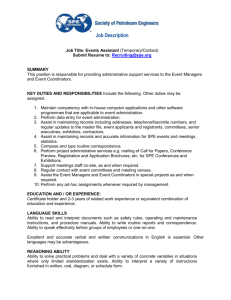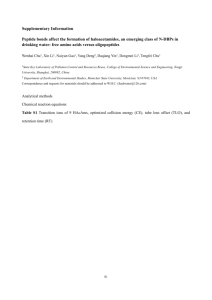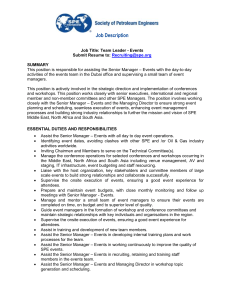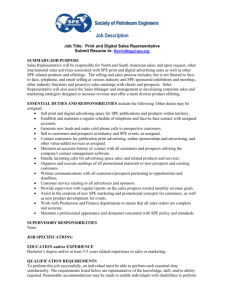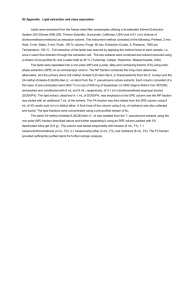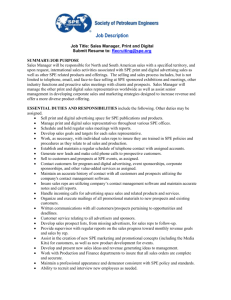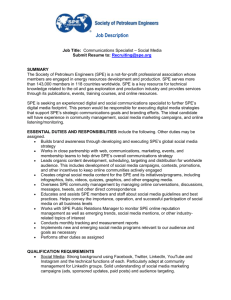capital expenditure justification report
advertisement
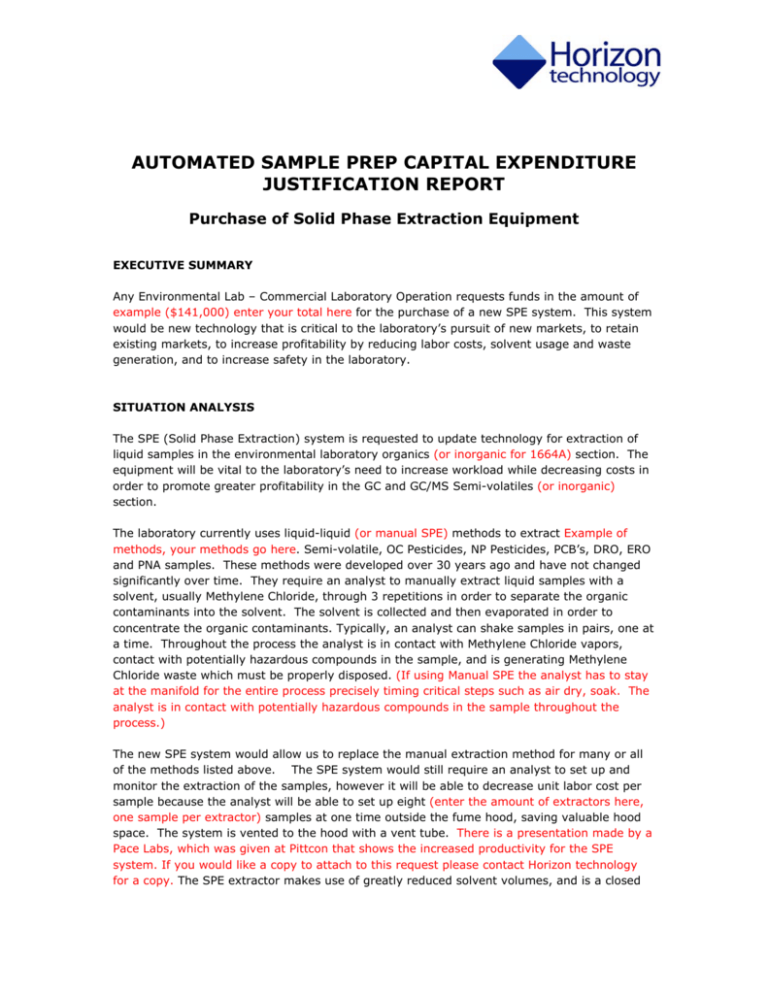
AUTOMATED SAMPLE PREP CAPITAL EXPENDITURE JUSTIFICATION REPORT Purchase of Solid Phase Extraction Equipment EXECUTIVE SUMMARY Any Environmental Lab – Commercial Laboratory Operation requests funds in the amount of example ($141,000) enter your total here for the purchase of a new SPE system. This system would be new technology that is critical to the laboratory’s pursuit of new markets, to retain existing markets, to increase profitability by reducing labor costs, solvent usage and waste generation, and to increase safety in the laboratory. SITUATION ANALYSIS The SPE (Solid Phase Extraction) system is requested to update technology for extraction of liquid samples in the environmental laboratory organics (or inorganic for 1664A) section. The equipment will be vital to the laboratory’s need to increase workload while decreasing costs in order to promote greater profitability in the GC and GC/MS Semi-volatiles (or inorganic) section. The laboratory currently uses liquid-liquid (or manual SPE) methods to extract Example of methods, your methods go here. Semi-volatile, OC Pesticides, NP Pesticides, PCB’s, DRO, ERO and PNA samples. These methods were developed over 30 years ago and have not changed significantly over time. They require an analyst to manually extract liquid samples with a solvent, usually Methylene Chloride, through 3 repetitions in order to separate the organic contaminants into the solvent. The solvent is collected and then evaporated in order to concentrate the organic contaminants. Typically, an analyst can shake samples in pairs, one at a time. Throughout the process the analyst is in contact with Methylene Chloride vapors, contact with potentially hazardous compounds in the sample, and is generating Methylene Chloride waste which must be properly disposed. (If using Manual SPE the analyst has to stay at the manifold for the entire process precisely timing critical steps such as air dry, soak. The analyst is in contact with potentially hazardous compounds in the sample throughout the process.) The new SPE system would allow us to replace the manual extraction method for many or all of the methods listed above. The SPE system would still require an analyst to set up and monitor the extraction of the samples, however it will be able to decrease unit labor cost per sample because the analyst will be able to set up eight (enter the amount of extractors here, one sample per extractor) samples at one time outside the fume hood, saving valuable hood space. The system is vented to the hood with a vent tube. There is a presentation made by a Pace Labs, which was given at Pittcon that shows the increased productivity for the SPE system. If you would like a copy to attach to this request please contact Horizon technology for a copy. The SPE extractor makes use of greatly reduced solvent volumes, and is a closed system, thus reducing the analysts contact with solvent and sample and generating far less waste reducing solvent and waste removal cost. The new SPE technology and changes to methodology would allow us to retain samples for tests we currently subcontract because we cannot meet requirements with our current extraction methods. This section applies to any samples you currently farm out you can now run on the Horizon technology system saving thousands of dollars. We have researched several new models to determine which may best suit our needs. Horizon systems has the longest presence in the marketplace, in addition, we currently have a Horizon SPE extractor in the General Laboratory section performing Oils and Grease extractions. We have also investigated manual SPE extraction, our studies confirmed our research that manual integration is not consistent, had poor precision and accuracy for three of our easier analyses – PCB’s, DRO and PNA’s, and was labor intensive. Horizon brought a system onsite or to a seminar, along with a technical representative and a sales representative for several days. They ran a number of real life samples for us we chose from among our clients, including some of the more difficult matrixes. They also provided us with references from other laboratories. PROPOSAL That we purchase one eight (enter the appropriate number of extractors for you here) station Horizon extractor and three (enter the number of DryVap systems if applicable here) automated Drying and Concentrating units that can be used for samples extracted on the SPE and on other equipment in the laboratory, including ASE extracted soils. Installation and initial training will be included in the purchase of the instrument. BENEFITS • The SPE extractor will allow the lab to reduce operating cost for current methods by reducing the amount of solvent used in the laboratory. Currently we use approximately 0.5 liters of Methylene Chloride per sample. The cost per liter is (enter your operations costs and numbers were necessary) $6.79 enter your cost here, with 2750 (enter your number) number of samples, not counting QC samples, solvent cost is $9,336 per year. The cost reduction for the GC group would be about 80% or $7,500. The cost savings may actually be greater than this when you include reducing other solvents and the use of this equipment for tests in the GC/MS group. In addition – the waste Methylene chloride must be properly disposed; the cost of a drum for disposal is (enter your numbers here)$165. We generate several drums a month (2X165X12months = $3,960). • The automated SPE extractor will allow personnel to increase efficiency; our greatest benefit should be reduced overtime labor during our busiest times of the year. (This section should contain the details of labor savings to be recognized by your organization) The GC section typically requires all employees to work one weekend day during the months of April and May (7 employees X 8 Hours at 1.5 X $14.00 X 8 weeks = $9,408) in order meet the workload demands. We should also be able to handle a greater volume of samples per day, assisting us with meeting the holding times and TAT of large projects. This system may allow us to continue to operate with the same number of personnel if we continue to see increases in sample load, especially in the FID tests. • The automated SPE extractor, through the reduction of solvent use would create a safer working environment for the analysts by reducing solvent exposure and inhalation. The laboratory must monitor and report Methylene Chloride exposure. The SPE would be a closed system and situated in a fume hood. The evaporating systems that are requested with the SPE are also closed systems, allowing us to trap the small amount of solvent that is generated during the concentration of the samples. • In addition the automated dry and concentration units will also reduce labor in the laboratory spent in the final preparation of sample extracts. (Your current technique with sodium sulfate and evaporation would go here)The samples are placed in water baths on hot plates and the solvent is boiled off. The analyst must be in attendance to prevent samples from boiling dry or “popping” resulting in the loss of analytes of interest. The automated drying and concentration units will hold six samples at a time and do not require a hood as opposed to two samples per fume hood, and can operate with unattended supervision. We tentatively hope to save 4 hours per day using this system; however it may save us more time than this. • The automated drying and concentration units can also be used to condense the extracts from the ASE used to process soil samples for PCB, ERO, Pesticide, DRO and PNA analysis. This will reduce the labor involved in these extractions and also reduce the chances of contamination for ERO and DRO samples. • In addition the automated drying and concentration units will also reduce glassware in the laboratory. The typical setup for the extraction and condensing of a sample would involve the use of a separatory funnel (add your costs here)($142.53), KD Flask ($51.38), Macrosnyder ($38.54), Microsnyder ($33.29), Ampule ($18.91), Teflon Stopper ($33.29) and Moonie Funnel ($11.25) for a total glassware setup cost of $313.65. The laboratory maintains a minimum of 18 of these setups representing $5,645.70 in glassware. Breakage accounts for approximately 48 of these setups at minimum being ordered a year for a cost of $15,055.20. The DryVap systems do make use of glassware; however breakages will be reduced because of the lack of moving parts. • The purchase of an SPE extractor would allow us to develop method 525.2 (your method here) and retain this test in house. (If you outsource these tests use this section, if not remove it) Please see the attachment showing recent subcontracted samples and associated revenue, in May of this year we subcontracted 123 samples with revenue of $35,240 and in June we subcontracted 66 samples with revenue of $18,275. Total revenue subcontracted since 2005 is $176,442, the total for the last 12 months is $116,780. The present listed cost for us to do this test in house is $87.00, the samples are sent to Lab X at a charge of $260 each. Although we pass this charge to the client, we lose the profit of $173 per sample ($260-$87). • (Other business ramifications) The laboratory has been recently informed by XXX that in order to compete successfully for future work we need to develop new methods and technologies. The XXX work being discussed is $300,000 of Pesticide, Fungicide, and other contaminants. This work would be shared with Lab X, who at present is doing all of the work, they would continue to do the HPLC/ MS. Much of the work would be done on GC/MS and the SPE would be an ideal extraction method. • The SPE extractor would allow us to more competitive with low profit contracts. We would reduce our cost for (your methods here) ERO work with XXX, allowing us to create profit in a growing market. ERO work for the laboratory has been on a steady increase over the last three years. Please see the attachment breaking down the last several years of increased FID work. FID is a target market for the GC group, allowing us to create another “niche” that does not use conflicting instrumentation with PCB work. The laboratory has recently bid on a large contract with XXX that includes ERO and GRO work, along with other FID methods. • The SPE extractor would also allow us to increase customer satisfaction. By allowing us to increase daily extractions we can increase sample throughput and bring down sample TAT. Large projects that are rush have been difficult for the laboratory to handle, however, we can anticipate and increased ability to meet more of our clients rush requests. The SPE also will help with tests that are sensitive to common laboratory interferences. For example, the ERO test can easily be contaminated by the chemicals and cleansers we use for the glassware that this test is extracted in, and any lubricants used in the lab or the working parts of the fume hoods. The analysts spend a great deal of time minimizing these contaminants. However, we have had to raise the detection limit of the ERO samples 10 fold this spring in order to accommodate the interferences. This has been a subject of concern for XXX, XXX and XXX. Because the SPE extractor eliminates much of the glassware needed to perform extractions, the chances of interferences are greatly reduced. The SPE equipment, by preventing atmospheric contamination, could reduce reextractions by 20%, and would allow us to lower the detection limit. • The SPE will allow us to utilize technological advancements to explore new markets. The laboratory is actively working to recognize and develop new avenues of revenue. As in the XXX example above, new technology is needed in order to ease the cost of development and increase the profit potential. The areas of endocrine disruptors and personal care products/pharmaceuticals would involve water samples being tested for product impact on the environment and to monitor bioaccumulation. Summary list of cost impact with your operations numbers BENEFIT Reduced solvent use Waste Disposal Reduce Labor Reduce Solvent Contact Reduce Labor Reduce Glassware Method 525.2 IDEM contract work ERO work Reduce ERO contamination Future markets IMPACT $9336 $3960 $9408 unknown $7280 $15,055 $116,780 $150,000 $10,000 Unknown Unknown DESCRIPTION Reduction in solvent use Less waste generated Reduction of O.T. Safety Allow Analysts Flexibility Alleviate replacement costs Maintain profit in-house Conoco Philips Atmospheric Contamination reduced Endocrine Disruptors, Personal Products, Pharmaceuticals TOTAL: $321,819 ASSUMPTION/RISKS A new SPE will make improvements in the analytical abilities of the laboratory. In purchasing only one SPE system we may find that it is overburdened with the sample volume load due to increased business that could be generated by the technology proposed and that two systems may eventually be needed. In determining future markets for the SPE it may be crucial in maintaining and developing a relationship with XXX. They continue to pursue investigations into markets not presently regulated but generating a great deal of interest, including but not limited to personal care products, fate and transport of pharmaceuticals, endocrine disruptors and neutraceuticals. ALTERNATIVES Continue to operate in the present manner, anticipating the increase in expenses primarily due to increasing solvent, waste disposal, analyst labor and analyst turnover costs. Method 525.2 and possibly other work would continue to be subcontracted to anther laboratory, reducing our profitability for this test.

